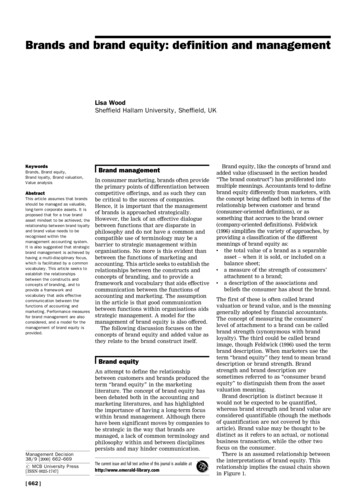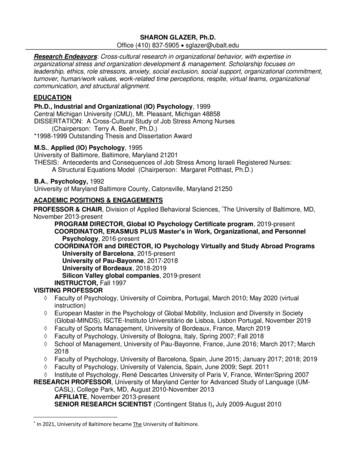
Transcription
Brand Management“Without question, branding is a complex management area that deserves study from avariety of different perspectives and academic traditions. By providing a multi-disciplinaryapproach, this textbook provides a welcome and invaluable resource for thoughtful students,scholars, and practitioners who want to fully understand branding and brand management.”Kevin Lane Keller, Tuck School of Business at Dartmouth“At last a book that cuts through the clutter about understanding brand and so clearly clarifies the brand concept. A book that superbly bridges the academic domain and enablespractitioners use it to build brand equity.”Leslie de Chernatony, Birmingham University Business School“We think this is an excellent treatment of our topic. Thorough and complete, yet conciseand very readable. We love the design and structure, both with regards to the sevenapproaches, as well as to the four layers within each approach.”Albert M. Muniz, Jr., DePaul University and Thomas C. O’Guinn, University of WisconsinFor over two decades it has been argued that the brand is an important value creator andshould therefore be a top management priority. However, the definition of what a brand isremains elusive.This comprehensive book presents the reader with an exhaustive analysis of the scientific and paradigmatic approaches to the nature of brand as it has developed over the lasttwenty years. Taking a multidisciplinary approach and offering an exhaustive analysis ofbrand research literature, it delivers a thorough understanding of the managerial implications of these different approaches to the management of the brand.Brand Management: Research, theory and practice fills a gap in the market, providingan understanding of how the nature of brand and the idea of the consumer differ in theseapproaches, and offers in-depth insight into the opening question of almost every brandmanagement course: ‘What is a brand?’Tilde Heding and Charlotte F. Knudtzen both lecture in strategic brand management atCopenhagen Business School. Tilde and Charlotte have published widely, while alsorunning their own brand management consultancy, Heding & Knudtzen. Mogens Bjerre isassociate professor of Marketing at Copenhagen Business School. He has published extensively in the fields of franchising, key accounts management, strategic relationshipmarketing and retailing.
Brand ManagementResearch, theory and practiceTilde Heding, Charlotte F. Knudtzenand Mogens Bjerre
First published 2009 by Routledge2 Park Square, Milton Park, Abingdon, Oxon OX14 4RNSimultaneously published in the USA and Canadaby Routledge270 Madison Ave, New York, NY 10016Routledge is an imprint of the Taylor & Francis Group, an informa businessThis edition published in the Taylor & Francis e-Library, 2008.“To purchase your own copy of this or any of Taylor & Francis or Routledge’scollection of thousands of eBooks please go to www.eBookstore.tandf.co.uk.” 2009 Tilde Heding, Charlotte F. Knudtzen and Mogens BjerreTypeset in Times New Roman by Saxon Graphics Ltd, DerbyPrinted and bound in Great Britain by MPG Books, BodminAll rights reserved. No part of this book may be reprinted or reproduced orutilised in any form or by any electronic, mechanical, or other means, nowknown or hereafter invented, including photocopying and recording, or inany information storage or retrieval system, without permission in writingfrom the publishers.British Library Cataloguing in Publication DataA catalogue record for this book is available from the British LibraryLibrary of Congress Cataloguing in Publication DataLibrary of Congress Cataloging-in-Publication DataHeding, Tilde.Brand management : research, theory and practice / Tilde Heding,Charlotte F. Knudtzen and Mogens Bjerre.p. cm.ISBN 978–0–415–44326–5 (hbk.) – ISBN 978–0–415–44327–2 (pbk.) –ISBN 978–0–203–99617–1 (ebook) 1. Brand name products–Management.2. Branding (Marketing) I. Knudtzen, Charlotte F. II. Bjerre, Mogens,1959- III. Title.HD69.B7H43 2008658.8 27–dc222008021896ISBN 0-203-99617-8 Master e-book ISBNISBN10: 0–415–44326–1 (hbk)ISBN10: 0–415–44327-X (pbk)ISBN10: 0–203–99617–8 (ebk)ISBN13: 978–0–415–44326–5 (hbk)ISBN13: 978–0–415–44327–2 (pbk)ISBN13: 978–0–203–99617–1 (ebk)
ContentsList of illustrationsList of tablesList of boxesForeword Leslie de ART ISetting the scene11Introduction32Key words in brand management93Overview: brand management 1985–200620PART IISeven brand approaches274The economic approach295The identity approach476The consumer-based approach837The personality approach1168The relational approach1519The community approach18110 The cultural approach207
vi ContentsPART IIITaxonomy24311 Taxonomy of brand management 1985–2006245Index260
List of e logic of the approach chaptersA readers’ guideThe brand–consumer exchange of the economic approachAssumptions of the economic approachSupporting themes of the economic approachCore theme and supporting themes of the economic approachTheoretical building blocks of the economic approachRelation between price and demandMethods and data of the economic approachSources of brand identityAssumptions of the identity approachSupporting themes of the identity approachBrand identity: the core theme and alignment frameworksof the identity approachAlignment of the strategic stars of brand identityTheory of the identity approachManifestations of organizational identity (culture)Methods and data of the identity approachDrivers of the alignment process of brand identityManagerial implications of the identity approachThe brand resides in the mind of the consumerThe computer is the central metaphor of man in cognitivepsychologyAssumptions of the consumer-based approachSupporting themes and the core themes of the consumer-basedapproachSimple associative network spreading from the nodeVolkswagenThe three forms of cognition applied to brandsDimensions of brand knowledgeAssociations spreading from the node ‘Seven up’‘Seven up’ brand associations adapted to the customer-basedbrand equity 7888990939697
viii List of eory of the consumer-based approachMethods and data of the consumer-based approachDualistic mechanisms of the consumer-based approachinfluencing the managerial implicationsManagerial implications of the consumer-based approachBrand personality constructAssumptions of the personality approachSupporting themes of the personality approachBrand behaviourConsumer self constructThe brand–self exchange of symbolic brand value in themarket placeCore theme of the personality approach: brand personalityDimensions of brand personalityTheory of the personality approachMethods and data of the personality approachBrand personality dimensions, traits and brand behaviourBrand–self congruence of Chanel No. 5Managerial implications of the personality approach‘Dyadic’ brand–consumer relationshipAssumptions of the relational approachSupporting themes and core theme of the relational approachPreliminary model of brand relationship quality and its effectson relationship stabilityTheoretical building blocks of the relational approachMethods and data of the relational approachManagerial implications of the relational approachThe ‘brand triad’Assumptions of the community approachSupporting themes of brand communityConceptualization of the community in the sociologicaltraditionBrand community constructTheoretical building blocks of the community approachMethods and data of the community approachThe marketer as observer of a brand communityThe marketer as facilitator of a brand communityManagerial implications of the community approachScope of the cultural approachAssumptions of the cultural approachThe core theme, its supporting theme, the societal commenton brand icons and the future brand scenarioThe movement of meaningIconic brands are brands that have become cultural iconsTheoretical building blocks of the cultural 198201203210213214215217224
List of illustrations ix10.710.810.910.1011.111.211.3Research methods of the cultural approachMethods and data of the cultural approachThe cultural brand management processManagerial implications of the cultural approachTaxonomy of brand management 1985–2006Two dimensions and four brand management paradigmsThe logic of the approach chapters227228229235246252257
List of .211.311.4Product and corporate brandingThe internal and external supporting themes adding up tobrand identityThree perspectives on organizational cultureDetecting identity gapsAligning identity gapsA simple version of a matrix arrayCreating brand personality in accordance with the consumerself constructRelationship formsDifferences between the information-processing and theexperiential consumer perspectiveVariations of brand communityA comparison between the mindshare branding model and thecultural branding modelThe postmodern and the post-postmodern branding paradigmThe roles of brandsFour brand management paradigmsA comparison of axioms across four branding modelsComparison of brand management 54255256
List of 6.46.56.66.76.87.17.27.37.47.57.67.77.88.1Overview of brand management 1985–2006Economic man: individual and societal maximization in asupermarket checkout queueTransactional versus relational perspective on brandmanagementRegression analysisThe identity concept adopted from marketingFrom product to corporate branding at LegoIs identity enduring?Culture in the identity approachMisaligned identities: the case of Body ShopDoing a study of brand identity yourselfLiving the brand: all about the people of QuiksilverDo’s and don’ts of the identity approachMemory representationsHeuristics are important in low-involvement categoriesHow to structure brand associationsProjective techniquesMap out customers’ brand associations yourselfThings to consider when choosing the right brand nameSix managerial guidelinesDo’s and don’ts of the consumer-based approachOil of Olay: female consumers’ hopes and dreamsArchetypes and brand personalityOrdinal scales appliedInterval scales applied‘Six steps’ method of exploring and measuring brandpersonalityBrand personalities in practiceWhen good brands do badDo’s and don’ts of the personality approachCustomer relationship management and brand 1102105107109126131135135137141145146152
xii List of .210.310.410.510.610.710.810.9Background of the brand relationship theoryThe complexity of a relationshipDepth is preferred to breadthStories can be helped alongConduct a long interview yourselfWho owns the Apple brand now?Getting too close?Solving the insider/outsider dilemmaQuantitative triangulation of qualitative dataHow to do an ethnographic study of a brand communityyourselfInsights from the Volkswagen ‘Beetle’ communityDo’s and don’ts in the community approachLibresse: the community principles applied to fast-movingconsumer goodsMacro-level culture definedHow Snapple became an iconic brandCivic responsibilities or cultural branding?Doing semioticsDoing a cultural study yourselfThe versatile brand manager of the cultural approachJust another legal case or an early warning sign?A citizen-artist brand?Do’s and don’ts in the cultural 218221225227230232232234
ForewordLeslie de ChernatonyGiven the research I have undertaken over the years helping managers understandthe nature of their brand and the opportunities for strategically growing brands, Iam delighted to write the foreword for this insightful and most timely book. Theauthors have done an extremely thorough job, diligently working through thebrand research literature to devise seven perspectives from diverse schools ofthought about perceptions of brands. From this typology, among other things, theyconsider how the all-important brand equity is created and managed. The authorsare to be congratulated on grounding this text so expertly in the literature yet stillenabling management implications to be wisely crystallized.Seeking to elucidate the nature of a brand is a daunting task, since brands arelike amoeba, constantly changing. At the most basic, brands start life in brandplanning documents, evolving as pan-company teams revise their ideas.Ultimately, after being finessed by stakeholders in the value chain, brands residein the minds and hearts of consumers – hopefully in a form not too dissimilar fromthat desired by the firm. The research neatly synthesized in this text coherentlybrings more understanding to the challenge of understanding a corporation’sbrand and managing its growth trajectory. It is clear from the authors’ work whydiverse interpretations exist about the nature of brands.From this well argued text it can be appreciated that one of the challengesmanagers face is finding a suitable metaphor to ensure common understanding ofthe firm’s brand. Without this, supporting brand resources may not be coherentlyintegrated. Furthermore, under the service dominant logic paradigm, it is morewidely recognized that brands are co-created through stakeholder interactions.Managers not only have to understand each other’s understanding and inputs tobrand building, but also to recognize the way brand communities want to shape thebrand. Again, the authors helpfully elucidate the importance of brand communities.There is much in this book that makes it an inspirati
Brand Management “Without question, branding is a complex management area that deserves study from a variety of different perspectives and academic traditions. By providing a multi-disciplinary approach, this textbook provides a welcome and invaluable resource for thoughtful students, scholars, and practitioners who want to fully understand branding and brand management.” Kevin Lane Keller .











